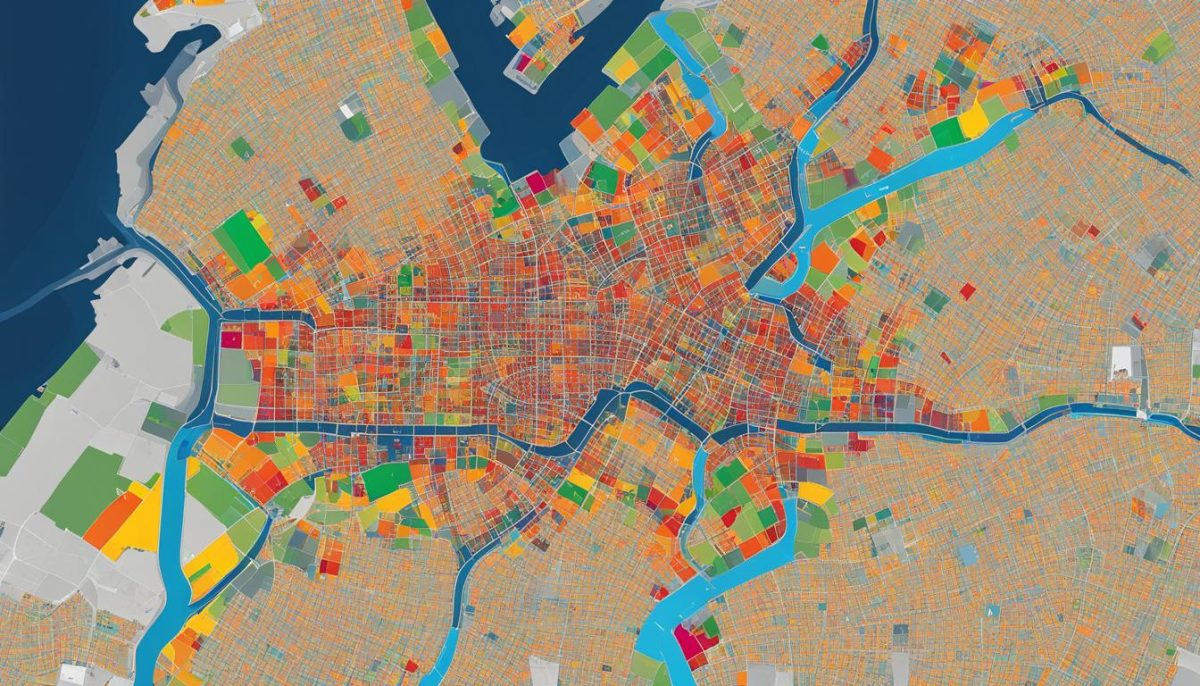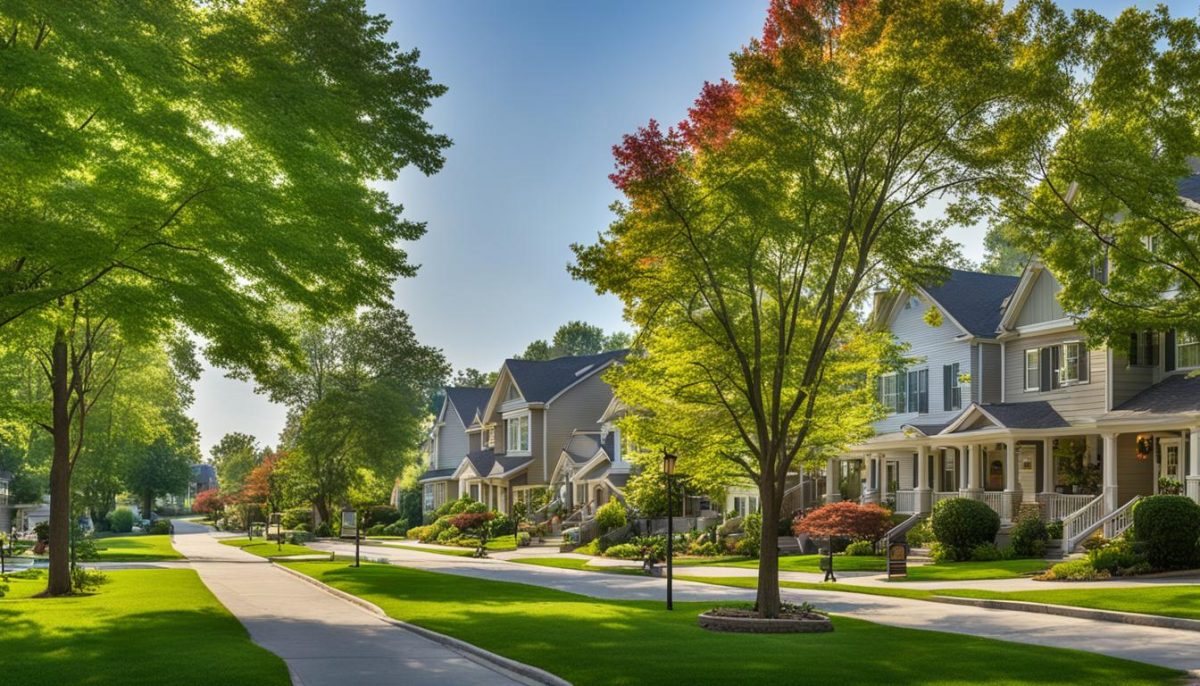News
Where to Buy Real Estate in Melbourne
Melbourne’s property market has entered the recovery phase after facing various challenges. The housing values in Melbourne have seen positive growth, with house prices rising by 1.8% over the quarter. This provides an opportunity for potential investors to enter the market. However, it’s important to note that Melbourne’s housing market is not homogeneous, and different suburbs offer different investment potential.
Key Takeaways:
- Melbourne’s property market is in the recovery phase, with positive growth in housing values.
- House prices in Melbourne have risen by 1.8% over the quarter.
- Investors should research different suburbs for the best investment potential.
- Melbourne’s housing market is not homogeneous, and each suburb offers different investment opportunities.
- Consider factors like demographics, local amenities, and neighborhood quality when choosing where to buy real estate in Melbourne.
Melbourne’s Property Market Recovery
After facing various challenges, Melbourne’s property market has entered the recovery phase, showing promising signs of growth. The economic impact of the Covid-19 pandemic and tighter lending restrictions posed significant obstacles, but the market has demonstrated resilience and has rebounded with vigor.
Over the past five months, Melbourne’s housing values have experienced consistent growth, indicating a newfound confidence and increasing interest in the market. This positive trend reflects a recovery phase in the property cycle, with property prices steadily increasing.
As Melbourne enters the recovery phase, it presents attractive opportunities for investors and homebuyers alike. The market dynamics, combined with the conducive economic environment, make it an opportune time to explore real estate options in Melbourne.
This recovery marks a turning point in Melbourne’s property market, offering potential investors a chance to capitalize on the upward trajectory. By carefully considering the recovery phase and the cyclical nature of the property market, investors can make informed decisions to maximize their returns.
The Property Cycle and Melbourne’s Recovery
The property cycle consists of four distinct phases: recovery, upswing, peak, and downturn. Each phase represents different stages of market activity and can offer valuable insights for investors. Understanding where the market currently stands can help investors navigate the real estate landscape with confidence.
During the recovery phase, the market begins to transition from a downturn, showing signs of improvement and growth. This phase follows a period of declining prices and economic uncertainty. As Melbourne’s property market recovers, house prices have demonstrated positive growth, signaling a renewed stability and optimism in the market.
The recovery phase presents opportunities for both seasoned investors looking to expand their property portfolio and first-time buyers seeking entry into the market. It is an ideal time to explore the available options, analyze market trends, and make strategic investment decisions.
Investors who enter the market during the recovery phase can position themselves for long-term capital growth. By taking advantage of the upward momentum in property prices, they can benefit from both rental income and future price appreciation.
Factors Driving Melbourne’s Recovery
The recovery phase in Melbourne’s property market has been fueled by a combination of factors that have contributed to the resurgence of market activity. These factors include:
- Economic stability: Improved economic conditions and a recovery in consumer sentiment have instilled confidence in the market.
- Low interest rates: Historically low interest rates have made borrowing more affordable, attracting buyers to the market.
- Government support: Various government initiatives, such as grants and incentives, have stimulated housing demand and provided additional support to the market.
These factors, coupled with the fundamental strengths of Melbourne’s property market, have paved the way for recovery and growth. It is crucial for investors to stay informed about market trends and leverage these favorable conditions to their advantage.
By capitalizing on the recovery phase, investors can position themselves for long-term success in Melbourne’s property market. However, it is important to conduct thorough research, seek professional advice, and consider individual investment goals and risk tolerance.
Factors Influencing Property Values
When it comes to understanding the property market in Melbourne, several factors have a significant impact on property values. While short-term fluctuations like interest-rate changes or government policies can play a role, the key long-term drivers are demographics and the wealth of the nation.
Demographics:
Demographic trends, such as population growth, age distribution, and household composition, shape the demand and supply dynamics of the housing market. Melbourne’s growing population, particularly in areas with strong job opportunities and amenities, contributes to increased property values. Additionally, demographic shifts, such as a rise in the number of young families or an aging population, can influence the types of properties in demand and their respective values.
Wealth:
The overall wealth of the nation has a substantial effect on property values. Economic factors such as GDP growth, employment rates, and income levels impact the purchasing power of individuals and their ability to invest in real estate. Melbourne, being one of Australia’s economic powerhouses, attracts both local and international investors, further driving property values.
While demographics and wealth are the primary long-term drivers of the property market, it’s essential to consider other local factors that can influence property values:
- Gentrification: Urban renewal projects and the revitalization of neighborhoods can lead to increased property values as demand for upgraded housing options grows.
- Neighborhood Quality: Factors like accessibility to amenities, transport links, schools, parks, and community infrastructure contribute to desirable neighborhoods, often leading to higher property values.
- Wage Growth: Rising wages and disposable incomes can influence affordability and demand for certain property types, resulting in changes in property values.
To fully understand the complexities of Melbourne’s property market, it’s crucial to analyze these long-term drivers and local factors that shape property values. This knowledge empowers investors to make informed decisions and take advantage of opportunities for capital growth.
“Demographics and wealth are the main long-term drivers of Melbourne’s property market. Understanding these factors, along with local influences, enables smarter investment decisions.”

| Factors | Impact on Property Values |
|---|---|
| Demographics | Strong population growth and shifting demographics can drive up property values. |
| Wealth | A thriving economy and higher income levels contribute to increased property values. |
| Gentrification | Renewed neighborhoods attract higher demand and drive property values upwards. |
| Neighborhood Quality | Access to amenities, good schools, and community infrastructure often leads to higher property values. |
| Wage Growth | Rising wages and disposable incomes can influence demand and property values. |
Top Suburbs in Melbourne for House Investments
When it comes to house investments in Melbourne, there are several suburbs that stand out for their strong property price growth. These suburbs offer attractive opportunities for investors looking to capitalize on the Melbourne real estate market.
One of the top suburbs for house investments is Elsternwick, which has experienced an impressive annual property price growth of 20.83%. This suburb offers a desirable location with easy access to amenities and a vibrant community.
Caulfield is another suburb worth considering, with its strong growth and popularity among homebuyers. This suburb boasts a convenient location, excellent schools, and a diverse range of housing options.
Mordialloc is also gaining attention for its property price growth, making it an attractive suburb for house investments. Its beautiful beachside location and proximity to amenities make it highly sought after by investors.
Lastly, Surrey Hills is a suburb that has seen positive growth in property prices. With its leafy streets, quality schools, and close proximity to the CBD, it offers a desirable lifestyle for homeowners and potential investors.
These suburbs provide excellent opportunities for house investments in Melbourne. With their strong property price growth and attractive features, they are definitely worth considering for investors looking to enter the market.
To give you a clearer overview, here is a table summarizing the property price growth in these top Melbourne suburbs:
| Suburb | Annual Property Price Growth |
|---|---|
| Elsternwick | 20.83% |
| Caulfield | 15.12% |
| Mordialloc | 12.05% |
| Surrey Hills | 8.76% |
As seen in the table, Elsternwick stands out with the highest annual property price growth among these top suburbs.
Investing in houses in these Melbourne suburbs can provide solid returns and potential for long-term capital growth. However, it’s important to conduct thorough research and seek professional advice before making any investment decisions.
Top Suburbs in Melbourne for Unit Investments
When it comes to investing in units in Melbourne, there are several suburbs that offer promising opportunities. These suburbs have shown positive rental yield and growth, making them attractive options for investors. Let’s explore some of the top suburbs for unit investments in Melbourne:
Caulfield
Caulfield, located in the southeast of Melbourne, is a sought-after suburb for unit investments. With its proximity to reputable universities and public transport options, Caulfield attracts a steady stream of tenants. The rental yield in Caulfield is impressive, providing investors with a solid return on their investment.
McKinnon
McKinnon is another suburb worth considering for unit investments. Situated in the Bayside area, McKinnon offers a vibrant lifestyle with excellent schools and convenient access to amenities. The suburb has experienced steady growth in capital value, making it an attractive option for long-term investment.
Beaumaris
Nestled along the coast of Port Phillip Bay, Beaumaris is a picturesque suburb that offers great potential for unit investments. With its beachside location and proximity to shopping precincts, Beaumaris attracts tenants seeking a relaxed coastal lifestyle. The rental yield in Beaumaris is favorable, making it an appealing choice for investors.
Other suburbs that present good investment opportunities for units include Bentleigh, Glen Waverley, and Box Hill. These suburbs offer a combination of convenient amenities, strong rental demand, and potential for capital growth. Investors should consider their investment goals and conduct thorough research before making a decision.
For a visual representation of the top suburbs in Melbourne for unit investments, refer to the table below:
| Suburb | Rental Yield | Growth Rate |
|---|---|---|
| Caulfield | 5.8% | 9.2% |
| McKinnon | 5.4% | 7.9% |
| Beaumaris | 5.1% | 6.5% |
| Bentleigh | 4.9% | 6.2% |
| Glen Waverley | 4.7% | 5.8% |
| Box Hill | 4.6% | 4.9% |
Investing in units in these suburbs offers the potential for both rental income and long-term capital appreciation. However, it’s essential for investors to conduct thorough research, seek professional advice, and consider their own financial goals and risk tolerance before making any investment decisions.

Best Melbourne Suburbs for Rental Yield
When it comes to investing in Melbourne suburbs, rental yield plays a crucial role in determining the profitability of investment properties. For those seeking high rental yield, Cheltenham and Highett, Parkdale, and Caulfield are among the top suburbs to consider. These suburbs have consistently delivered strong rental returns, making them attractive choices for investors.
In Cheltenham and Highett, the rental market is thriving, with low vacancy rates and a high demand for quality rental properties. The weekly rents in these suburbs are competitive, allowing investors to generate a steady rental income. Additionally, both suburbs have experienced good annual rent growth, indicating a positive outlook for future returns.
Parkdale is another suburb worth considering for rental yield. With its proximity to the beach and excellent amenities, Parkdale attracts tenants looking for a desirable lifestyle. The demand for rental properties in Parkdale remains high, ensuring consistent rental income for investors. Moreover, the suburb offers a good balance of affordability and rental return, making it an appealing option for savvy property investors.
Caulfield, known for its vibrant lifestyle and proximity to the city, also presents an opportunity for attractive rental yield. The suburb enjoys low vacancy rates and strong demand from tenants, contributing to a healthy rental market. With its well-established infrastructure and accessibility to public transport, Caulfield offers an enticing investment proposition with steady rental income and the potential for capital growth.
Suburbs for Rental Yield:
- Cheltenham and Highett
- Parkdale
- Caulfield
Other Melbourne suburbs such as Beaumaris, Mordialloc, and Hampton also offer attractive rental yields for investment properties. These suburbs boast a combination of high rental demand, low vacancy rates, and solid rental growth. Investors looking to maximize their rental yield should consider these suburbs as part of their property portfolio.
| Suburb | Vacancy Rate | Weekly Rent | Annual Rent Growth |
|---|---|---|---|
| Cheltenham and Highett | 2% | $550 | 4.5% |
| Parkdale | 1.5% | $580 | 5.2% |
| Caulfield | 1.8% | $600 | 4.8% |

Suburbs to Watch in Melbourne – Location Analysis
When it comes to investing in Melbourne’s property market, location is a crucial factor in determining the potential for growth and returns. We have analyzed various suburbs in Melbourne and identified the top ones to watch based on their location, amenities, and property value trends.
Caulfield, Elsternwick, Ormond, and Bentleigh are among the suburbs that have caught our attention. These suburbs offer proximity to essential amenities such as shopping centers, schools, and public transport options. They have also experienced positive growth in property values, making them attractive investment opportunities.
In addition to the aforementioned suburbs, McKinnon, Brighton, and Hampton also present promising investment prospects. These suburbs boast desirable locations, excellent schooling options, and a strong sense of community, all of which contribute to their investment potential.
Suburbs to Watch in Melbourne – Location Analysis
| Suburb | Proximity to Amenities | School Ratings | Property Price Growth |
|---|---|---|---|
| Caulfield | Close to shopping centers, public transport, and parks | Highly rated schools within the vicinity | Consistent positive growth in property values |
| Elsternwick | Easy access to amenities, cafes, and restaurants | Well-regarded schools nearby | Significant increase in property prices |
| Ormond | Conveniently located near shops, train stations, and parks | Excellent schools in the area | Steady rise in property values |
| Bentleigh | Close proximity to schools, parks, and public transport | Schools with strong reputations nearby | Positive growth in property prices |
| McKinnon | Well-connected to amenities, cafes, and local shops | Highly regarded schools within reach | Emerging growth in property values |
| Brighton | Ample amenities, shopping strips, and beautiful beaches | Top-rated schools in the vicinity | Stable and consistent growth in property prices |
| Hampton | Proximity to shops, cafes, parks, and the beach | Excellent schooling options nearby | Increase in property values |
These suburbs stand out due to their desirable location, access to amenities, and positive property price growth. Whether you are looking for a long-term investment or seeking rental yields, these suburbs offer compelling opportunities.
Investing in suburbs with strong location analysis can increase your chances of capital growth and rental demand. Consider these suburbs to watch in Melbourne when making your investment decisions.

Western Suburbs vs. Eastern Suburbs in Melbourne
Melbourne’s property market can be compared to a Monopoly board, with the Western Suburbs offering more affordable prices and the Eastern Suburbs known for their higher property prices. The Eastern suburbs, with their proximity to the CBD and established infrastructure, have seen greater capital growth. However, Western Suburbs like Williams Landing and Altona Meadows offer more affordable options for buyers.
| Suburb | Western Suburbs | Eastern Suburbs |
|---|---|---|
| Average Property Prices | Affordable | Higher |
| Proximity to CBD | Further | Closer |
| Capital Growth | Steady | Greater |
| Infrastructure | Developing | Established |
| Transport Links | Expanding | Well-connected |
When considering a property investment in Melbourne, it’s important to weigh the advantages and disadvantages of the Western Suburbs and the Eastern Suburbs. While the Eastern Suburbs offer the appeal of proximity to the CBD, established infrastructure, and higher capital growth potential, the Western Suburbs present more affordable options for buyers who value affordability and are willing to embrace developing areas with potential for future growth.

Choosing Between Houses and Units
When it comes to real estate investment, choosing between houses and units depends on the investor’s preferences and goals. Both options offer unique advantages and considerations. Let’s explore the key factors to help you make an informed decision.
Houses: Long-Term Potential
Investing in houses provides greater long-term options and potential for capital growth. With a house, you have the freedom to renovate, expand, or modify the property according to your vision. This flexibility allows you to adapt to changing market trends and demands.
Moreover, houses typically offer more space, both indoor and outdoor, providing a greater sense of privacy and a backyard for recreational activities or gardening. These features can make houses particularly attractive to families or individuals seeking a spacious living environment.
Units: Lower Costs, Good Rental Yield
On the other hand, units offer distinct advantages, especially for those focused on generating rental income. Units tend to have lower running costs compared to houses, as they typically have shared maintenance responsibilities and lower utility expenses.
In addition, units often require less maintenance and upkeep, making them ideal for investors who prefer a hands-off approach. The reduced maintenance requirements can free up your time and resources for other investment opportunities.
If located in the right suburb with high rental demand, units can provide a good rental yield. This can be especially lucrative for investors looking for regular cash flow without the need for significant capital investment.
Consider Your Investment Strategy
When deciding between houses and units, it’s crucial to align your decision with your investment strategy and goals. Consider the following questions:
- What is your desired investment timeframe?
- Are you looking for long-term capital growth or immediate rental income?
- Do you have the resources and inclination for property maintenance and renovation?
Answering these questions will help guide you towards the most suitable investment option.
Ultimately, the choice between houses and units boils down to your personal preferences, investment goals, and the potential of each property type in your targeted market.
“Choosing between houses and units depends on the investor’s preferences and goals.”
Ultimately, conducting thorough market research and consulting with experienced professionals can help you make an informed decision that aligns with your investment goals and maximizes your returns.
| Comparison: Houses vs. Units | |
|---|---|
| Houses | Units |
| Long-term potential for renovation and expansion | Lower running costs |
| Potential for capital growth | Reduced maintenance requirements |
| Spacious living environment and backyard | Good rental yield in high-demand suburbs |
Factors Influencing Suburb Investment Potential
When considering suburb investment potential, several key factors can influence the desirability and growth prospects of a location. These factors include access to infrastructure, quality schools, a range of amenities, and proximity to public transport. Additionally, suburbs with natural amenities like bays, rivers, or parks can further enhance their investment appeal.
Infrastructure plays a vital role in determining a suburb’s investment potential. Areas with well-developed transport networks, including roads, trains, trams, and buses, provide convenience and accessibility for residents. Improved infrastructure often leads to increased demand for properties, boosting capital growth over time.

Another crucial factor is the presence of quality schools within a suburb. Families often seek out areas that offer reputable educational institutions, which can have a positive impact on property values. Strong academic performance, a wide range of extracurricular activities, and well-maintained facilities are all factors that contribute to a suburb’s desirability.
A diverse range of amenities is also important when assessing investment potential. Suburbs that provide lifestyle amenities such as shopping centers, restaurants, cafes, parks, and recreational facilities offer residents convenience and an enjoyable living experience. These amenities contribute to the overall appeal of a suburb and can drive demand for housing, resulting in potential capital growth.
“Investors often seek suburbs with established infrastructure, quality schools, and a range of amenities to capitalize on potential capital growth.”
Proximity to public transport is another key consideration for investors. Suburbs with easy access to public transportation options, such as train stations or bus stops, offer residents convenience and connectivity to other areas of interest. This accessibility can attract potential tenants or buyers, ensuring steady demand for housing in the suburb.
Suburbs that benefit from natural amenities like bays, rivers, or parks can provide a unique selling point for investors. These natural features offer opportunities for outdoor recreation and a sense of serenity. Properties located near these natural amenities may experience increased demand and potential capital growth.
Overall, suburbs with established infrastructure, access to quality schools, a diverse range of amenities, and convenient public transport options stand out as potential investment hotspots. These factors contribute to a suburb’s desirability, attracting buyers and tenants alike and offering the potential for long-term capital growth.
Researching Melbourne’s Property Market
When it comes to investing in Melbourne’s real estate market, conducting thorough property research and suburb analysis is crucial for making informed decisions. By exploring past sale prices, observing current trends, and analyzing the demand and supply dynamics, you can identify potential investment opportunities in this dynamic market.
One valuable resource for property research is online platforms like Domain and Realestate.com.au. These websites provide comprehensive information on property prices, rental yields, and suburb data. You can easily access detailed statistics, charts, and maps that can help you gain insights into the Melbourne market and individual suburbs.
By utilizing these platforms, you can perform in-depth suburb analysis, comparing different areas and neighborhoods based on crucial factors like proximity to amenities, schools, public transport, and lifestyle offerings. These platforms often provide additional data on demographics, crime rates, and local infrastructure, allowing you to make well-informed decisions aligned with your investment objectives.
Moreover, attending property seminars, networking events, and engaging with local real estate professionals can provide you with expert insights and a deeper understanding of the Melbourne property market. By leveraging a network of knowledgeable professionals, you can refine your research and gain access to off-market opportunities that are not publicly advertised.
Benefits of Property Research and Suburb Analysis
Through diligent property research and suburb analysis, you can:
- Identify hotspots and emerging suburbs: By tracking market trends and analyzing suburb data, you can identify areas experiencing rapid growth and future potential.
- Understand rental yields and potential returns: Suburb analysis enables you to assess rental yields, vacancy rates, and potential income from your investment properties.
- Evaluate market demand and supply: By analyzing factors such as population growth, development pipeline, and housing supply, you can gauge the demand and supply dynamics of a particular suburb.
- Make informed investment decisions: Armed with comprehensive research, you can confidently choose the suburbs and property types that align with your investment goals and risk appetite.
“Research is essential when venturing into the real estate market. By staying informed and understanding the nuances of different suburbs, you can position yourself for success and maximize your investment potential.”
– Real Estate Expert

| Key Factors for Property Research | Effectiveness |
|---|---|
| Past sale prices | Highly effective in understanding market trends and property values. |
| Suburb trends | Provides insights into the growth potential and performance of different areas. |
| Demand and supply dynamics | Helps identify areas with strong market demand and limited supply, driving property values. |
| Proximity to amenities | A crucial factor influencing property values and rental demand. |
| School zones | Affects property demand and can be a key consideration for families. |
| Lifestyle offerings | Suburbs with popular cafes, parks, and recreational facilities tend to attract higher demand. |
Finding the Right Property in Melbourne
Looking for your dream property in Melbourne? We’re here to help you navigate the exciting world of real estate and find the perfect home. When it comes to property search, Melbourne offers a wide range of options to suit different preferences and budgets.
One of the primary channels for finding properties in Melbourne is through real estate agents. These professionals have access to a vast network of properties and can help you find options that align with your requirements. They have local market knowledge and can guide you through the buying process.
Additionally, online platforms like Domain and Realestate.com.au are invaluable resources for property search. These platforms provide extensive listings, allowing you to explore different suburbs and filter properties based on your preferences. You can easily browse through photos, property details, and even schedule inspections.
It’s crucial to thoroughly inspect properties before making an offer or bidding at an auction. This is your opportunity to assess the condition of the property, check for any hidden issues, and envision yourself living there. Remember, buying a property is a significant investment, so take the time to ensure it meets your expectations.

Costs to Consider When Buying a Property
| Costs | Description |
|---|---|
| Homebuyer Grants | Financial assistance provided by the government to eligible first home buyers. |
| Stamp Duty | A state or territory tax imposed on property purchases. |
| Legal and Conveyancing Fees | Costs associated with legal processes and ensuring smooth property transactions. |
| Insurance Costs | Expenses for building, contents, and other relevant insurance policies. |
| Ongoing Expenses | Rates, utilities, and mortgage repayments that need to be accounted for on a regular basis. |
Temporary Resident Rules and Regulations
As a temporary resident in Australia, it’s important to be aware of the specific rules and regulations that apply when purchasing property. These guidelines are in place to ensure a transparent and regulated property market for all residents and to oversee foreign investment. One of the key requirements is notifying the Foreign Investment Review Board (FIRB) when purchasing residential real estate.
Temporary residents are permitted to buy established dwellings to live in or build new dwellings, subject to foreign investment approval. This approval ensures that the investment aligns with Australia’s national interest and doesn’t undermine the availability of housing for Australian residents. It’s essential for temporary residents to comply with these rules to avoid any legal complications during the property purchase process.
It’s worth noting that permanent residents of Australia, who hold a permanent visa or Australian citizenship, do not require foreign investment approval when purchasing property. Permanent residents have greater flexibility and freedom in their property investment decisions, while temporary residents need to adhere to the designated guidelines to ensure compliance.
FAQ
Where are the best places to buy real estate in Melbourne?
Some of the top suburbs in Melbourne for house investments include Elsternwick, Caulfield, Mordialloc, and Surrey Hills. For unit investments, Caulfield, McKinnon, and Beaumaris are recommended. Cheltenham and Highett, Parkdale, and Caulfield are among the best suburbs in Melbourne for rental yield.
What is the current state of Melbourne’s property market?
Melbourne’s property market has entered the recovery phase after facing various challenges. The housing values in Melbourne have seen positive growth, with house prices rising by 1.8% over the quarter.
What factors influence property values in Melbourne?
Demographics and the wealth of the nation are considered the main long-term drivers of Melbourne’s property market. Other factors such as gentrification, neighborhood quality, and wage growth also play a significant role in determining capital growth.
Which suburbs in Melbourne offer good investment potential for houses?
Elsternwick, Caulfield, Mordialloc, and Surrey Hills are among the top suburbs in Melbourne for house investments.
Which suburbs in Melbourne offer good investment potential for units?
Caulfield, McKinnon, and Beaumaris are some of the top suburbs in Melbourne for unit investments.
Which suburbs in Melbourne have the best rental yield?
Cheltenham and Highett, Parkdale, and Caulfield are among the best suburbs in Melbourne for rental yield.
Which suburbs in Melbourne are worth watching based on their location analysis?
Caulfield, Elsternwick, Ormond, and Bentleigh are some of the suburbs to watch in Melbourne based on their location analysis.
What are the differences between Western Suburbs and Eastern Suburbs in Melbourne?
Melbourne’s property market can be compared to a Monopoly board, with Western Suburbs offering more affordable prices and Eastern Suburbs known for their higher property prices.
Should I invest in a house or a unit in Melbourne?
Choosing between houses and units depends on the investor’s preferences and goals. Houses offer more long-term options for renovation, expansion, and potential capital growth. Units have lower running costs, reduced maintenance requirements, and can provide good rental yield if located in the right suburb.
What factors influence the investment potential of a suburb in Melbourne?
Suburbs with high investment potential share common factors such as access to infrastructure, good schools, lifestyle amenities, and proximity to public transport.
How can I research Melbourne’s property market?
Researching Melbourne’s property market involves considering factors like past sale prices, suburb trends, and analyzing the demand and supply dynamics. Websites like Domain and Realestate.com.au provide valuable information on property prices, rental yields, and suburb data.
How do I find the right property in Melbourne?
Properties in Melbourne are typically sold through real estate agents, and online platforms like Domain and Realestate.com.au offer extensive listings. It’s important to inspect properties before making an offer or bidding at auction, and conducting property and pest inspections is advisable to ensure there are no hidden issues.
How can I finance a property purchase in Melbourne?
Financing a property purchase in Melbourne usually involves obtaining a home loan from a bank, credit union, or mortgage broker. Pre-approval is recommended to determine the borrowing capacity before looking for a property.
What are the additional costs involved in buying a property in Melbourne?
Additional costs to consider when buying a property include stamp duty, legal and conveyancing fees, insurance costs, and ongoing expenses like rates, utilities, and mortgage repayments.
Are there any restrictions for temporary residents buying property in Melbourne?
Temporary residents in Australia have specific rules and regulations to follow when buying property. They need to notify the Foreign Investment Review Board if purchasing residential real estate. Temporary residents are allowed to buy established dwellings to live in or build new dwellings.
